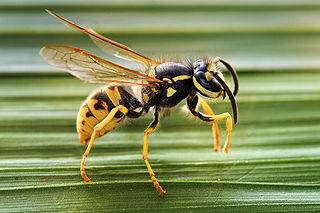 W
WColeopterology is a branch of entomology, the scientific study of beetles of the order Coleoptera. Practitioners are termed coleopterists. Coleopterists have formed organizations to facilitate the study of beetles. Among these is The Coleopterists Society, an international organization based in the United States. Such organizations may have both professionals and amateurs as members, interested in beetles.
 W
WTrue flies are insects of the order Diptera, the name being derived from the Greek δι- di- "two", and πτερόν pteron "wing". Insects of this order use only a single pair of wings to fly, the hindwings having evolved into advanced mechanosensory organs known as halteres, which act as high-speed sensors of rotational movement and allow dipterans to perform advanced aerobatics. Diptera is a large order containing an estimated 1,000,000 species including horse-flies, crane flies, hoverflies and others, although only about 125,000 species have been described.
 W
WForensic entomology is the scientific study of the invasion of the succession pattern of arthropods with their developmental stages of different species found on the decomposed cadavers during legal investigations. It is the application and study of insect and other arthropod biology to criminal matters. It also involves the application of the study of arthropods, including insects, arachnids, centipedes, millipedes, and crustaceans to criminal or legal cases. It is primarily associated with death investigations; however, it may also be used to detect drugs and poisons, determine the location of an incident, and find the presence and time of the infliction of wounds. Forensic entomology can be divided into three subfields: urban, stored-product and medico-legal/medico-criminal entomology.
 W
WHuman interactions with insects include both a wide variety of uses, whether practical such as for food, textiles, and dyestuffs, or symbolic, as in art, music, and literature, and negative interactions including serious damage to crops and extensive efforts to eliminate insect pests.
 W
WLepidopterology, is a branch of entomology concerning the scientific study of moths and the three superfamilies of butterflies. Someone who studies in this field is a lepidopterist or, archaically, an aurelian.
 W
WThe discipline of medical entomology, or public health entomology, and also veterinary entomology is focused upon insects and arthropods that impact human health. Veterinary entomology is included in this category, because many animal diseases can "jump species" and become a human health threat, for example, bovine encephalitis. Medical entomology also includes scientific research on the behavior, ecology, and epidemiology of arthropod disease vectors, and involves a tremendous outreach to the public, including local and state officials and other stake holders in the interest of public safety.
 W
WMelittology is a branch of entomology concerning the scientific study of bees. It may also be called apicology. Melittology covers the species found in the clade Anthophila within the superfamily Apoidea, comprising more than 20,000 species, including bumblebees and honey bees.
 W
WMyrmecology is a branch of entomology focusing on the scientific study of ants. Some early myrmecologists considered ant society as the ideal form of society and sought to find solutions to human problems by studying them. Ants continue to be a model of choice for the study of questions on the evolution of social systems because of their complex and varied forms of eusociality. Their diversity and prominence in ecosystems also has made them important components in the study of biodiversity and conservation. Recently, ant colonies are also studied and modeled for their relevance in machine learning, complex interactive networks, stochasticity of encounter and interaction networks, parallel computing, and other computing fields.
 W
WThe Odonata are an order of flying insects that includes the dragonflies and damselflies. Like most other flying insects, they evolved in the early Mesozoic era. Their prototypes, the giant dragonflies of the Carboniferous, 325 mya, are no longer placed in the Odonata but included in the Protodonata or Meganisoptera.
 W
WThe Vespidae are a large, diverse, cosmopolitan family of wasps, including nearly all the known eusocial wasps and many solitary wasps. Each social wasp colony includes a queen and a number of female workers with varying degrees of sterility relative to the queen. In temperate social species, colonies usually only last one year, dying at the onset of winter. New queens and males (drones) are produced towards the end of the summer, and after mating, the queens hibernate over winter in cracks or other sheltered locations. The nests of most species are constructed out of mud, but polistines and vespines use plant fibers, chewed to form a sort of paper. Many species are pollen vectors contributing to the pollination of several plants, being potential or even effective pollinators, while others are notable predators of pest insect species.